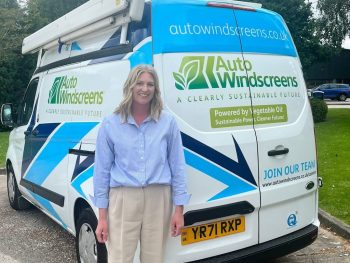The challenge of decarbonising commercial fleets is ongoing. Shannon Lomas, fleet manager at Auto Windscreens, details how her business has addressed this issue.

Like many organisations, there is a stark contrast in progress between Auto Windscreens’ decarbonisation of its company car fleet versus its van fleet. While we have made great progress transitioning the cars to EVs, our vans present a far more testing challenge.
We have trialled many EVs over the years. We began our tests in 2018 – and it quickly became apparent that our technicians were spending so much time charging them that it affected our productivity and, ultimately, our customer service. We continued our trials across a wide range of LCVs – and continue to do so. While we feel we are getting closer, there is still not a solution that enables us to transition all of our operational fleet to EVs.
Switching to EVs
Of the nearly 350 vans that make up our commercial fleet, none is currently electric or hybrid. However, we are focused on maximising our ‘low-hanging fruit, working closely with charge point providers and analysing route trends through trackers fitted to our vans to establish mileage requirements.
This project has enabled us to identify pockets of the country where we are increasingly confident that we could roll out electric vans tomorrow with little to no impact on our technicians or customers. However, with other options available, the question of when and to what extent we switch to EVs is not a decision we want, or need, to rush into.
Public charging network issues
A recent survey of our workforce revealed that over half do not have the option of installing a charger at home. This poses an issue, as our technicians take their vans home at night. If the vans were left at a depot equipped with chargers overnight, it wouldn’t be an issue but, as it is, we have to rely on the public charging network.
Unfortunately, the public charging infrastructure still needs to expand and the servicing of the public chargers should be improved. I have spoken to many of our electric car drivers who say that they often arrive at a charging point, only to find that it is unavailable. So then, they have to find another one – and sometimes that is out of service too.
Trialling other options
While we continue to research potential EV solutions, we recognise the importance of testing other options in parallel. In August 2023, we began trialling hydrotreated vegetable oil (HVO) in some of our commercial vans. Since then, we have seen little difference in the way the vehicles operate, which is reassuring and in line with expectations.
HVO-powered vans maintain the same fuel consumption as their diesel counterparts, but have fewer servicing requirements, display smoother engine performance and are unaffected by issues associated with diesel particulate filters. These vans are capable of running both diesel and HVO without any modification, which offers an exciting avenue for more sustainable fleet operations.
I do not think electric vehicles will be the only option for commercial fleets as we move forward. We want to make sure we have tried everything – HVO, electric and other sustainable fuels – so that when these options become more established and commercially viable, we are in a good position to benefit from them. In order to decarbonise our commercial fleet and help the business meet its target of being net zero by 2045 through a combination of alongside emissions reduction plans, finding a sustainable alternative to diesel is an absolute must.

